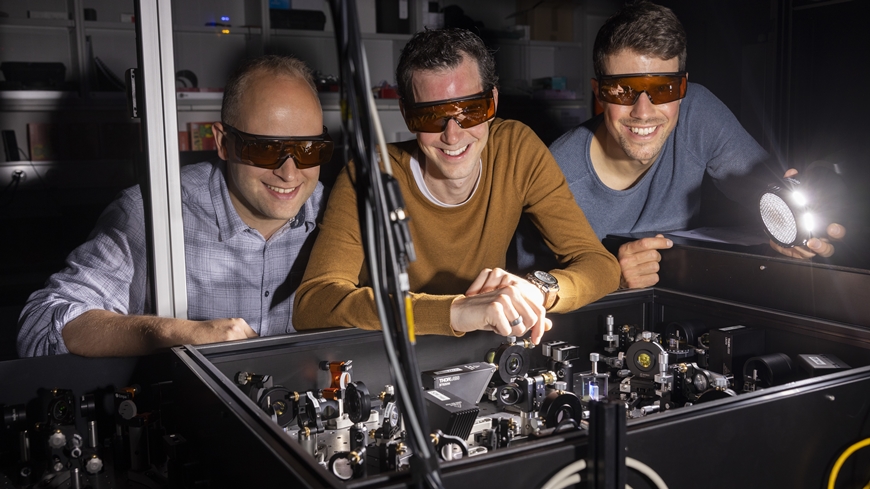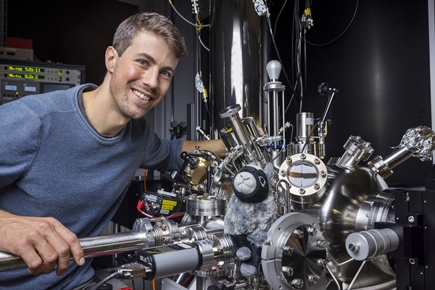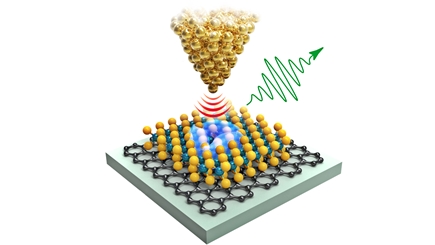Quantum technology
Masters of defects
Bruno Schuler and his young team are embarking on an ambitious research project: He will selectively generate defects in atomically-thin semiconductor layers and attempt to measure and control their quantum properties with simultaneous picosecond temporal resolution and atomic precision. The resulting insights are expected to establish fundamental knowledge for future quantum computers.

The term molybdenum disulfide may sound familiar to some car drivers and mechanics. No wonder: the substance, discovered by US chemist Alfred Sonntag in the 1940s, is still used today as a high-performance lubricant in engines and turbines, but also for bolts and screws. This is due to the special chemical structure of this solid, whose individual material layers are easily displaceable relative to one another. However, molybdenum disulfide (chemically MoS2) not only lubricates well, but it is also possible to exfoliate a single atomic layer of this material or to grow it synthetically on a wafer scale. The controlled isolation of a MoS2 monolayer was achieved only a few years ago, but is already considered a materials science breakthrough with enormous technological potential. The Empa team now wants to work with precisely this class of materials.
The layered structure of individual atomic layers makes this material interesting for physicists in search of base materials for next-generation nanocomputers. MoS2 – and its chemical relatives called transition metal dichalcogenides (TMDs) – are one of the main "shootingstars" in a whole range of two-dimensional (2D) materials. TMDs are 2D semiconductors and have a direct band gap, but only as a single layer, making them particularly attractive for ultimate miniaturized integrated circuits or optical detectors. The robust quantum mechanical properties of 2D materials are also being intensively explored for use in quantum metrology, quantum cryptography, and quantum information technology.
But not only the base material matters, but in particular also the ability to manage defects in there: Analogous to chemical doping of "classical" semiconductors in integrated circuits or foreign ions in solid-state lasers, atomic defects are "like the icing on the cake," especially in 2D materials, Schuler said.
Atomically-thin quantum computers?

The Empa researcher wants to characterize atomic defects in TMDs using a novel type of instrument and investigate their suitability as so-called quantum emitters. Quantum emitters form the interface between two worlds: electron spin – the quantum mechanical analogue of the electron torque – which is suitable for processing quantum information, and photons, i.e. light particles, which can be used to transmit quantum information over long distances without loss. 2D materials offer the great advantage that the relevant energy scales are much larger than for 3D materials, so it is expected that the technology can be used above cryogenic environments – ideally even at room temperature. In addition, the defects have to be located on the surface of the 2D material, making them much easier to find and manipulate.
But first, the defects in the two-dimensional MoS2 layer have to be detected and their electronic and optical properties have to be investigated precisely. Precise, in this case means that the location under investigation is explored to the accuracy of one angstrom. For comparison: 1 angstrom is to a meter what 4 cm is to the distance Earth-Moon (400,000 km). And the snapshot used to record the electronic excitation of the quantum dot must be accurate down to one picosecond (ps) – 1 ps is as small of a fraction of a second as 2 days are compared to the age of planet Earth (5 billion years). These ultrashort and atomically precise measurements then provide a very detailed picture of what dynamic processes are occurring on an atomic scale and what factors are affecting those processes.
An apparatus made of two halves
The apparatus in which the experiments will take place is already located in a room in the basement of Empa's laboratory building in Dübendorf – where the floor is the most stable. "We have invested over a year and a half of preparation and development work to complete our experimental setup," Bruno Schuler explains. "In October 2022, we connected the two halves of our system and were able to measure lightwave-induced currents for the first time. The principle works! A huge milestone in the project."
The two halves that Schuler's team will now work with are, on the one hand, a scanning tunneling microscope (STM). An ultrathin tip is used to scan the atomic surface of the sample. The scientists will position the tip at a defect site, i.e., a vacancy or a "foreign" atom in the structure.
Then the second half of the system, which Schuler's colleague Jonas Allerbeck has set up, comes into play: A 50-watt infrared laser sends ultrashort laser pulses onto a nonlinear lithium niobate crystal. This generates a phase-stable electromagnetic pulse in the terahertz frequency range. This pulse is only a single oscillation of light long and can be split with special optics into a pair of pump and probe pulse – both of which follow each other with variable delay and can measure the electron dynamics in a stroboscopic manner.
An electron "jumps" onto the defect site

The two pulses are then sent into the STM and directed to the probe tip. The first pulse detaches an electron from the tip, which "jumps" onto the defect site of the two-dimensional MoS2 layer and excites electrons there. "This can be either an electric charge, a spin excitation, a lattice vibration or an electron-hole pair that we create there," Schuler explains. "With the second pulse, we then look a few picoseconds later at how our defect site responded to the excitation pulse and by that we can study decoherence processes and energy transfer into the substrate."
In this way, Schuler is one of only a few specialists in the world to combine picosecond-short time resolution with a method that can "see" individual atoms. The team makes use of the intrinsic localization of states in the 2D material system to hold excitations in one place long enough to be detected. "The ultrafast lightwave scanning probe microscope enables fascinating new insights into quantum mechanical processes at the atomic scale, and 2D materials are a unique materials platform to create these states in a controlled way," says the Empa researcher.
An ERC Starting Grant
Bruno Schuler and his team, the optics specialist Jonas Allerbeck and PhD student Lysander Huberich, who works on the scanning tunneling microscope, are supported by funding from the European Research Council. The ERC Starting Grant supports particularly talented young scientists – the Champions League of the European research community. Schuler brought the best prerequisites with him: He studied physics at ETH Zurich and specialized in his doctorate at the birthplace of scanning tunneling microscopy, the IBM research laboratory in Rüschlikon. As a postdoc and later as a group leader at the Lawrence Berkeley National Lab in the US, he conducted his first research on 2D materials and coordinated an international research team.
He now wants to use this experience to strengthen and further develop Empa as a research hub for quantum nanotechnology. "We have the privilege of breaking new scientific ground with this project and observing things for the first time that no one has seen before," Schuler says. At Empa, Bruno Schuler's research group is part of the nanotech@surfaces lab lead by Roman Fasel. The internationally renowned group conducts research on quantum effects in low-dimensional organic and inorganic nanostructures, which could form a basis for next-generation quantum computers.
Dr. Bruno Schuler
nanotech@surfaces
Phone +41 58 765 4929
-
Share

| A scary (bio-)film |
|
Bacteria have formed a biofilm at the root of a tooth (beige). It causes tooth decay and inflammation. Empa researchers are investigating these successful communities and are developing biomedical materials to keep the pathogens at bay. |
|
In the danger zone |
|
Empa researchers are developing a heat-resistant drone that can analyze the source of danger at close range in the event of a fire. This allows firefighters to optimize the strategy of a high-risk operation before entering the danger zone. |







